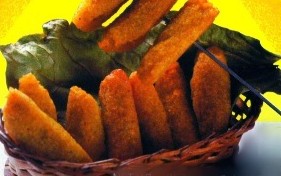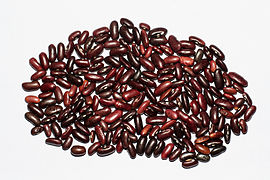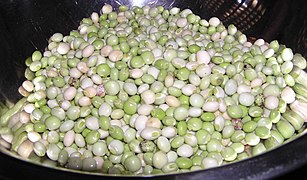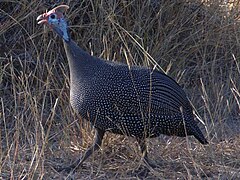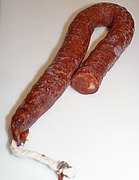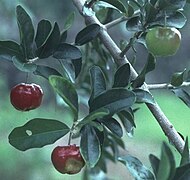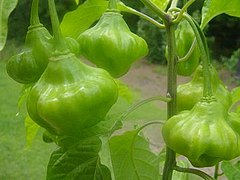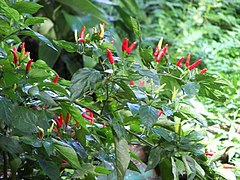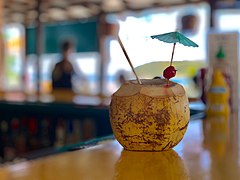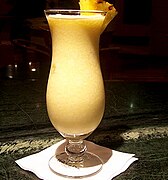Puerto Rican cuisine: Difference between revisions
Boricuamark (talk | contribs) Tag: Reverted |
Boricuamark (talk | contribs) Tag: Reverted |
||
| Line 12: | Line 12: | ||
===Taíno influence=== |
===Taíno influence=== |
||
''See: [[ |
''See: [[Taíno|Taíno food and agriculture]]'' |
||
From the diet of the [[Taíno people|Taíno]] (culturally related with the [[Maya civilization|Maya]] and [[Kalina people|Carib]] peoples of Central America and the [[Caribbean]]) and Arawak people come many tropical roots and tubers (collectively called viandas) like ''yautía'' ([[Xanthosoma]]) and especially ''[[Cassava|yuca]]''. ''Viandas'' are starchy [[list of root vegetables|root vegetables]], including [[yuca]], [[Dioscorea trifida|ñame mapuey]], yautía amarilla, [[Xanthosoma sagittifolium|yautía lila]], yautía blanca, ''[[Goeppertia allouia|lerén]]'', [[Ipomoea batatas|batata mameya]] (sweet potato), batata (white sweet potato with purple skin), [[Xanthosoma brasiliense|calalu]], and ''[[arracacha|apio criollo]]'', all locally grown in the mountain regions of the Island.<ref>[http://www.cridag.net/industrias/raices-y-tuberculos/ ''Raíces y Tubérculos.''] Centro de Recursos Informativos Digitales Agrícolas de Puerto Rico (CRIDAg). University de Puerto Rico en Mayaguez. 2018. Accessed 8 December 2018.</ref> |
From the diet of the [[Taíno people|Taíno]] (culturally related with the [[Maya civilization|Maya]] and [[Kalina people|Carib]] peoples of Central America and the [[Caribbean]]) and Arawak people come many tropical roots and tubers (collectively called viandas) like ''yautía'' ([[Xanthosoma]]) and especially ''[[Cassava|yuca]]''. ''Viandas'' are starchy [[list of root vegetables|root vegetables]], including [[yuca]], [[Dioscorea trifida|ñame mapuey]], yautía amarilla, [[Xanthosoma sagittifolium|yautía lila]], yautía blanca, ''[[Goeppertia allouia|lerén]]'', [[Ipomoea batatas|batata mameya]] (sweet potato), batata (white sweet potato with purple skin), [[Xanthosoma brasiliense|calalu]], and ''[[arracacha|apio criollo]]'', all locally grown in the mountain regions of the Island.<ref>[http://www.cridag.net/industrias/raices-y-tuberculos/ ''Raíces y Tubérculos.''] Centro de Recursos Informativos Digitales Agrícolas de Puerto Rico (CRIDAg). University de Puerto Rico en Mayaguez. 2018. Accessed 8 December 2018.</ref> |
||
Revision as of 06:11, 10 February 2022
This article needs additional citations for verification. (March 2013) |
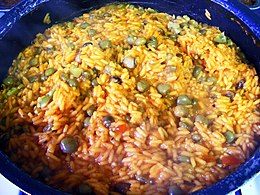
| Part of a series on |
| American cuisine |
|---|
 |
Puerto Rican cuisine has its roots in the cooking traditions and practices of Europe (mostly Spain), Africa and the native Taínos.
History

Puerto Rican cuisine has been influenced by an array of cultures including Taino Arawak, Spanish, and African.[4] Although Puerto Rican cooking is somewhat similar to both Spanish and other Latin American cuisine, it reflects a unique blend of influences, using indigenous seasonings and ingredients. Locals call their cuisine cocina criolla. By the end of the nineteenth century, the traditional Puerto Rican cuisine was well established. By 1848 the first restaurant, La Mallorquina, opened in Old San Juan.[5] El Cocinero Puerto-Riqueño o Formulario, the island's first cookbook, was published in 1849.[6]
Taíno influence
See: Taíno food and agriculture
From the diet of the Taíno (culturally related with the Maya and Carib peoples of Central America and the Caribbean) and Arawak people come many tropical roots and tubers (collectively called viandas) like yautía (Xanthosoma) and especially yuca. Viandas are starchy root vegetables, including yuca, ñame mapuey, yautía amarilla, yautía lila, yautía blanca, lerén, batata mameya (sweet potato), batata (white sweet potato with purple skin), calalu, and apio criollo, all locally grown in the mountain regions of the Island.[7]
Among spices are the ajicito or cachucha pepper, a very mild chili known for it smokiness, pimienta (allspice), achiote (annatto), peppers, varieties of zamia, arrowroots, ají picante, and ají caballero (the hottest pepper native to Puerto Rico). Among drinks are chicha, sarsaparilla, and mabí. Among fruits are guava, pineapple, guanabanas (soursop), quenepas (mamoncillo), mamey, sugar-apple, annona squamosa, avocado, pepino, and annona reticulata. Herbs where also grown for medical and culinary use. Among these herds are Puerto Rican orégano (not the same as orégano brujo), Aztec sweet herb, avocado leaves (used like bay leaves), chiococca alba, securidaca, petiveria, canellaceae, and recao (spiny leaf coriander).
Spanish/European influence
See: Spanish cuisine

Spanish/European influence is also prominent in Puerto Rican cuisine. Melon, radish, celeriac (apio), celery, peas, cumin, onions, garlic, cilantro (using plant, root, and seeds), mint, parsley, thyme, tarragon, sage, basil, marjoram, oregano, orégano brujo, bayleaves, grapes, eggplant, olives, and capers. Livestock came from Europe, including horses, domestic pigeon, rabbit, cattle, pigs, sheep, goats, and chickens all came to Puerto Rico among other fruits, spices, and herbs. Over time, new crops were introduced to the Puerto Rico, including wheat, rice, barley, oats, coffee, sugar cane, citrus fruits, and Kentucky bluegrass. Early Dutch, French, and Italian immigrants influenced not only the culture but Puerto Rican cooking as well. This great variety of traditions came together to form La Cocina Criolla. Spanish dishes are still a part of the island's traditional cooking.
African influence
See: African cuisine
Coconuts, okra, taro (malanga coco), eddoe (malanga blanca), tamarind, yams (ñame), sesame seeds, bitter melon, gandules (pigeon peas), plantains, many varieties of bananas, other root vegetables and Guinea hen, all came to Puerto Rico from, or at least through, Africa. African slaves also introduced the deep-frying of food, such as cuchifritos.[8]African cooking and dishes have a strong bound on the island's history. The most beloved dish are of African descent such as Afro-Puerto Rican pastlese and probably the most two icon dishes mofongo and tostones. The green banana called guinoe verde. Green bananas are used in everyday cooking in Puerto Rican households and is a staple in holiday dishes.[9]African cooking and dishes have a strong bound on the island's history. The most beloved dish are of African descent such as Afro-Puerto Rican pastlese and probably the most two icon dishes mofongo and tostones.
Regional
Arecibo
Arecibo is the biggest municipality in Puerto Rico by area and is located on the northern coast. Arecibo is known[by whom?] for its heavy use of cumin and coriander seeds making dishes smokey and flavorful. In the river of Río Grande de Arecibo whitebait called cetí is caught.[10]
Basic ingredients
Seafood and shellfish
On certain coastal towns of the island, such as Luquillo, Fajardo, and Cabo Rojo, seafood is quite popular.

- Cetí – A type of whitebait found in Arecibo.[11]
- Chillo – Red snapper is a favorite among the locals.[12]
Seasoning blends
Traditional cooking on the island uses more fresh and local ingredients such as citrus to make mojo (sauce), ajilimójili, and mojito isleño.[13]
The base of many Puerto Rican main dishes involves sofrito or recaíto, similar to the mirepoix of French cooking, or the "trinity" of Creole cooking. A proper sofrito is a sauté of freshly ground garlic, tomatoes, onions, recao/culantro, cilantro, red peppers, cachucha and cubanelle peppers. Sofrito is traditionally cooked with olive oil or annatto oil, tocino (bacon), salted pork and cured ham. A mix of stuffed olives and capers called alcaparrado are usually added with spices such as bay leaf, sazón and adobo.[14]
Puerto Rican dishes

Although Puerto Rican diets can vary greatly from day to day, there are some markedly similar patterns to daily meals. Dinners almost invariably include a meat, and rice and beans.[4]
Thanksgiving dishes
Most American dishes have been adopted for this special day. Side dishes such as cornbread, roasted yams, mashed potatoes with gravy, hard apple cider, and cranberry sauce are a part of a Puerto Rican Thanksgiving menu.[citation needed]
- Dulce – The fusion of American mainland and Puerto Rican food can be clearly seen in Thanksgiving desserts. Puerto Rican desserts use the same traditional ingredients as American holiday desserts including pumpkin, yams, and sweet potatoes. Classic sweets are infused with sweet viandas. Flan de calabasas (squash flan), Tortitas de Calabaza (pumpkin tarts), Cazuela (a pie made with pumpkin, sweet potato, coconut, and sometimes carrots), Barriguitas de Vieja (deep-fried sweet pumpkin fritters made with coconut milk and spices), Cheese cake with tropical fruit, Buñuelos de Calabasas o platáno (pumpkin or sweet plantains doughnuts), and Budín de Pan y calabasas (bread pudding made from squash bread).[15]
Christmas dishes
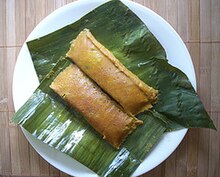
Puerto Rican culture can be seen and felt all year-round, but it is on its greatest display during Christmas when people celebrate the traditional aguinaldo and parrandas – Puerto Rico's version of carol singing. Puerto Rican food is a main part of this celebration.[16]
Beverages

- Chocolate Caliente – Hot chocolate made with coco, vanilla, milk, spices, small amount of edam cheese, and topped with whipped cream.[17]
Kiosks
See: Cuchifrito for Puerto Rican fried food
Rustic stalls displaying many kinds fritters under heat lamps or behind a glass pane can be spotted in may place in Puerto Rico. Collectively known as frituras in Puerto Rico, these snacks are called cuchifritos in New York City, but to be strictly correct, cuchifritos are the mom-and-pop stores where frituras are sold. In Puerto Rico, the name quiscos (kiosk) is used to refer to the cuchifrito.[18][19] Quioscos are a much-frequented, time-honored, and integral part to a day at the beach and the culinary culture of the island. Fresh octopus and conch salad are frequently seen. Much larger kiosks serve hamburgers, local/Caribbean fusion, Thai, Italian, Mexican and even Peruvian food. This mixing of the new cuisine and the classic Puerto Rican food. Alcoholic beverage are a big part of kiosks with most kiosks having a signature drink.
Puerto Rican food outside Puerto Rico
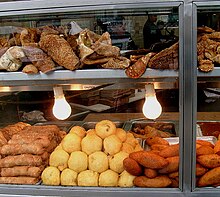

- Cuchifritos – In New York, cuchifritos are quite popular. Cuchifritos, often known as "Puerto Rican soul food"[by whom?] includes a variety of dishes, including, but not limited to: morcilla (blood sausage), chicharron (fried pork skin), patitas (pork feet), masitas (fried porkmeat), and various other parts of the pig prepared in different ways.
- Jibarito (Plaintain Sandwich) – In Chicago, El Jibarito is a popular dish.[20] The word jíbaro in Puerto Rico means a man from the countryside, especially a small landowner or humble farmer from far up in the mountains. Typically served with Puerto Rican yellow rice, Jibaritos consist of a meat along with mayonnaise, cheese, lettuce, tomatoes and onions, all sandwiched between a fried plantain, known as a canoa (canoe). In the early 20th century, bread made from wheat (which would have to be imported) was expensive out in the mountain towns of the Cordillera Central, and jíbaros were made from plantains which are still grown there on the steep hillsides. The version introduced to Chicago was originally made with skirt steak, but today it can be found in versions made with chicken, roast pork, ham, shrimp and even the vegetarian option tofu is available.[21]
Chefs
- Alfredo Ayala – was recognized as the father of Puerto Rican modern cuisine[22]
- Doreen Colondres – chef, television presenter, food writer and sommelier.
- Luis Antonio Cosme – famous Puerto Rican actor and television chef
- Giovanna Huyke – famous television chef
- Dora Romano – author of "Cocine Conmigo[23]" written in 1972
- Daisy Martinez – author of Daisy Cooks: Latin Flavors That Will Rock Your World written in 2005 and Daisy: Morning, Noon and Night written in * of Daisy Cooks! on PBS and ¡Viva Daisy! on the food network
- Maria Perez – author of Tropical Cooking Made Easy [24] written in 2007
Gallery
-
Rotisserie chicken, twice-fried plantain in Ciales, Puerto Rico
-
Cilantro leaves
-
Alcapurrias
-
Papa rellena de Puerto Rico
-
Mofongo, prepared in New York
-
red kidney beans (habichuelas coloradas)
-
pigeon peas (gandules)
-
Yuca, Puerto Rican name for cassava
-
Guinea Hen
-
Chorizo
-
Acerola cherry
-
Green and red cubanelle peppers are used to make sofríto
-
Plantain "arañitas" and "tostones rellenos"
-
Ajicitos / Cachucha, a.k.a., Ají Dulce, the Habanero chili pepper's mild cousin
-
Ajíes caballero (aka, Puerto Rican Jelly Bean Hot Chili Pepper) is a very hot local pepper
-
Marinated cassava (Spanish: Yuca en escabeche)
-
Parcha, passion fruit, is often made into passion fruit juice
-
Coconut with straw at restaurant in Esperanza, Vieques
-
Pique (Puerto Rican Hot Sauce)
-
Piña Colada
-
Puerto Rican cooking has a unique blend of influences.
-
Grilled yellow snapper with green papaya salad and tostones
See also
References
- ^ Reporter's Notebook. York Daily Record (York, Pennsylvania). 15 December 2003. Page 35. Accessed 24 January 2021.
- ^ El Gusto Boricua en el Sur de la Florida. Yined Ramírez-Hendrix. El Nuevo Herald (Miami, Florida). 27 July 2011. Page D12. Accessed 24 January 2021.
- ^ Sofrito, imprescindible para latinos. Viviana Caraballo. El Nuevo Herald (Miami, Florida). 6 January 1999. p. 19. Accessed 24 January 2021.
- ^ a b Albala, Ken (2011). Food Cultures of the World Encyclopedia. Greenwood. p. 656 – via Temple University.
- ^ Porter, Darwin; Prince, Danforth (June 25, 2007). Frommer's Portable Puerto Rico. Wiley. ISBN 9780470100523.
- ^ Ortiz, Yvonne. A Taste of Puerto Rico: Traditional and New Dishes from the Puerto Rican Community. Penguin group, 1997. P. 3
- ^ Raíces y Tubérculos. Centro de Recursos Informativos Digitales Agrícolas de Puerto Rico (CRIDAg). University de Puerto Rico en Mayaguez. 2018. Accessed 8 December 2018.
- ^ "A slice of Puerto Rican history". The Salt Lake Tribune.[permanent dead link]
- ^ "A slice of Puerto Rican history". The Salt Lake Tribune.[permanent dead link]
- ^ "Historia del Cetí en Puerto Rico y el Caribe". foodiespr.com (in Spanish). February 3, 2015. Retrieved August 25, 2019.
- ^ Historia del Cetí en Puerto Rico y el Caribe. Ferdinand Quiñones. FoodiesPR.com February 2015. Accessed 25 January 2022. Archived.
- ^ [https://www.primerahora.com/noticias/puerto-rico/notas/nos-gusta-el-bacalao-pero-el-chillo-es-el-rey-de-la-mesa-puertorriquena/ Nos gusta el bacalao, pero el chillo es el rey de la mesa puertorriqueña Según varios expertos, el chillo es el pescado favorito de los consumidores del país.] Agustín Criollo Oquero. Primera Hora. 12 August 2014. Accessed 25 January 2022. Archive.
- ^ "The ultimate Puerto Rican food guide". Explore Parts Unknown. October 1, 2017. Retrieved August 25, 2019.
- ^ Taylor, David (June 5, 2020). "Legendary Puerto Rican Cookbook Cocina Criolla begins with many details & Sofrito!". Hispanic Food Network. Retrieved June 22, 2020.
- ^ Ortiz Cuadra, Cruz Miguel (2013). Eating Puerto Rico: A History of Food, Culture, and Identity. Latin America in Translation/en Traducción/em Tradução. University of North Carolina Press. p. 82. ISBN 978-1-4696-0882-2. Retrieved October 12, 2019.
- ^ Five Favorite Puerto Rican Holiday Recipes: Tembleque. Discover Puerto Rico. Accessed 6 February 2022. Archived.
- ^ Halpern, Ashlea (April 30, 2014). "18 Things to Eat, Buy and Do in Puerto Rico - Casa Cortés ChocoBar". Bon Appetit. Condé Nast.
- ^ Frituras. Recetas Boricuas. Accessed 25 January 2022. Archived.
- ^ Las frituras son nuestro manjar-VÍDEO: Un sondeo informal por el área de Piñones demostró que la alcapurria es la gran favorita. Istra Pacheco. Primera Hora. 26 July 2013. Accessed 25 January 2022. Archived.
- ^ "Jibarito Sandwich: What You Need To Know". Retrieved April 28, 2016.
- ^ Bizzari, Amy (2016). Iconic Chicago Dishes, Drinks and Desserts. Arcadia. pp. 46–53. ISBN 9781467135511.
- ^ Solí, Por Yaira; Escudero, s; Vocero, El (November 14, 2016). "Fallece un 'boomer' ilustre: chef Alfredo Ayala". El Vocero de Puerto Rico (in Spanish). Retrieved November 18, 2020.
- ^ Romano, Dora R. de (1972). Cocine conmigo (in Spanish). ISBN 9788439910138.
- ^ Perez, Maria (2007). Tropical Cooking Made Easy. Hillcrest Publishing Group. ISBN 9781934248607.
External links
- El Boricua - Puerto Rican traditional recipes
- Carmen Santiago, Puerto Rican chef



